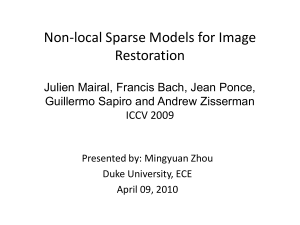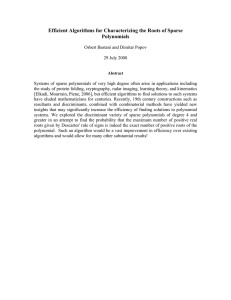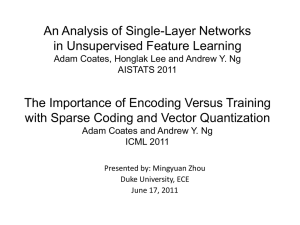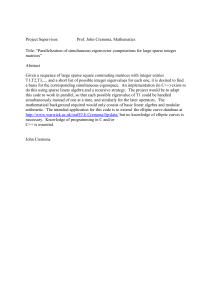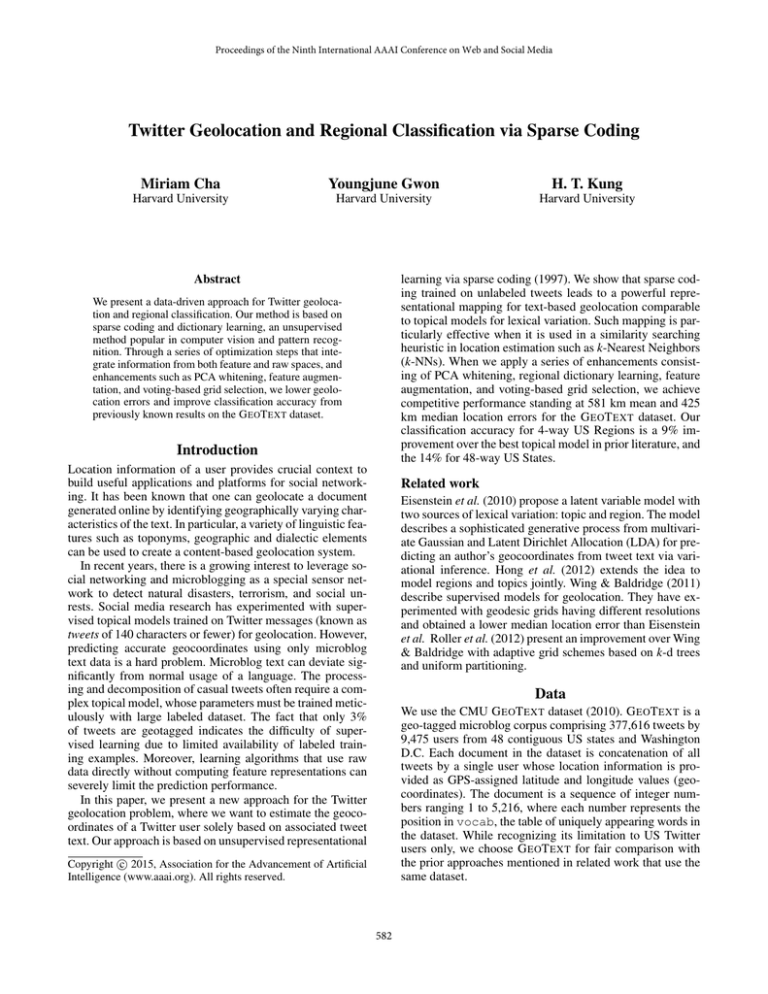
Proceedings of the Ninth International AAAI Conference on Web and Social Media
Twitter Geolocation and Regional Classification via Sparse Coding
Miriam Cha
Youngjune Gwon
H. T. Kung
Harvard University
Harvard University
Harvard University
Abstract
learning via sparse coding (1997). We show that sparse coding trained on unlabeled tweets leads to a powerful representational mapping for text-based geolocation comparable
to topical models for lexical variation. Such mapping is particularly effective when it is used in a similarity searching
heuristic in location estimation such as k-Nearest Neighbors
(k-NNs). When we apply a series of enhancements consisting of PCA whitening, regional dictionary learning, feature
augmentation, and voting-based grid selection, we achieve
competitive performance standing at 581 km mean and 425
km median location errors for the G EOT EXT dataset. Our
classification accuracy for 4-way US Regions is a 9% improvement over the best topical model in prior literature, and
the 14% for 48-way US States.
We present a data-driven approach for Twitter geolocation and regional classification. Our method is based on
sparse coding and dictionary learning, an unsupervised
method popular in computer vision and pattern recognition. Through a series of optimization steps that integrate information from both feature and raw spaces, and
enhancements such as PCA whitening, feature augmentation, and voting-based grid selection, we lower geolocation errors and improve classification accuracy from
previously known results on the G EOT EXT dataset.
Introduction
Location information of a user provides crucial context to
build useful applications and platforms for social networking. It has been known that one can geolocate a document
generated online by identifying geographically varying characteristics of the text. In particular, a variety of linguistic features such as toponyms, geographic and dialectic elements
can be used to create a content-based geolocation system.
In recent years, there is a growing interest to leverage social networking and microblogging as a special sensor network to detect natural disasters, terrorism, and social unrests. Social media research has experimented with supervised topical models trained on Twitter messages (known as
tweets of 140 characters or fewer) for geolocation. However,
predicting accurate geocoordinates using only microblog
text data is a hard problem. Microblog text can deviate significantly from normal usage of a language. The processing and decomposition of casual tweets often require a complex topical model, whose parameters must be trained meticulously with large labeled dataset. The fact that only 3%
of tweets are geotagged indicates the difficulty of supervised learning due to limited availability of labeled training examples. Moreover, learning algorithms that use raw
data directly without computing feature representations can
severely limit the prediction performance.
In this paper, we present a new approach for the Twitter
geolocation problem, where we want to estimate the geocoordinates of a Twitter user solely based on associated tweet
text. Our approach is based on unsupervised representational
Related work
Eisenstein et al. (2010) propose a latent variable model with
two sources of lexical variation: topic and region. The model
describes a sophisticated generative process from multivariate Gaussian and Latent Dirichlet Allocation (LDA) for predicting an author’s geocoordinates from tweet text via variational inference. Hong et al. (2012) extends the idea to
model regions and topics jointly. Wing & Baldridge (2011)
describe supervised models for geolocation. They have experimented with geodesic grids having different resolutions
and obtained a lower median location error than Eisenstein
et al. Roller et al. (2012) present an improvement over Wing
& Baldridge with adaptive grid schemes based on k-d trees
and uniform partitioning.
Data
We use the CMU G EOT EXT dataset (2010). G EOT EXT is a
geo-tagged microblog corpus comprising 377,616 tweets by
9,475 users from 48 contiguous US states and Washington
D.C. Each document in the dataset is concatenation of all
tweets by a single user whose location information is provided as GPS-assigned latitude and longitude values (geocoordinates). The document is a sequence of integer numbers ranging 1 to 5,216, where each number represents the
position in vocab, the table of uniquely appearing words in
the dataset. While recognizing its limitation to US Twitter
users only, we choose G EOT EXT for fair comparison with
the prior approaches mentioned in related work that use the
same dataset.
c 2015, Association for the Advancement of Artificial
Copyright Intelligence (www.aaai.org). All rights reserved.
582
Approach
in the US. In the following, we present our baseline methods
for these two tasks.
Geolocation. We use the following steps for geolocation.
Our approach is essentially semi-supervised learning. We
concern the shortage of labeled training examples in practice, and hence pay special attention on the unsupervised
part consisting of sparse coding and dictionary learning with
unlabeled data.
1. (Text embedding) perform binary, word-counts, or wordsequence embedding of raw tweet text, using vocab;
2. (Unsupervised learning) use unlabeled data patches to
learn basis vectors in a dictionary D;
Preliminaries
3. (Feature extraction) do sparse coding with labeled data
patches {(x(1) , l(1) ), (x(2) , l(2) ), . . . }, using the learned
dictionary D and yield sparse codes {y(1) , y(2) , . . . };
Notation. Let our vocabulary vocab be an array of words
with size V = |vocab|. A document containing W words
can be represented as a binary bag-of-words vector wBW ∈
{0, 1}V embedded onto vocab. The ith element in wBW
is 1 if the word vocab[i] has appeared in the text. We denote a word-counts vector wW C ∈ {0, 1, 2, . . . }V , where
the ith element in wW C now is the number of times the
word vocab[i] has appeared. We can also use a wordsequence vector wW S ∈ {1, . . . , V }W . That is, wi , the ith
element in wW S represents the ith word in the text, which is
vocab[wi ]. We use patch x ∈ RN , a subvector taken from
wBW , wW C , or wW S for an input to sparse coding. For mclass classification task, we use label l ∈ {c1 , c2 , . . . , cm },
where cj is the label value for class j. For geolocation task,
label l = (lat, lon) is the geocoordinate information.
Sparse coding. We use sparse coding as the basic means to
extract features from text. Given an input patch x ∈ RN ,
sparse coding solves for a representation y ∈ RK in the
following optimization problem:
min kx − Dyk22 + λ · ψ(y)
y
4. (Feature pooling) perform max pooling over a group
of M sparse codes from a user to obtain pooled
sparse code z such that the kth element in z, zk =
max(y1,k , y2,k , . . . , yM,k ) where yi,k is the kth element
from yi , the ith sparse code in the pooling group;
5. (Tabularization of known locations) build a lookup table
of reference geocoordinates associated with pooled sparse
codes z (from labeled data patches).
When tweets from unknown geocoordinates arrive, the
geolocation pipeline comprises preprocessing, feature extraction via sparse coding (without labels), and max pooling. Using the resulting pooled sparse codes of the tweets,
we find the k pooled sparse codes from the lookup table that
are closest in cosine similarity. We take the average geocoordinates of the k-NNs.
Region and state classification. We employ the following
method for classification.
(1)
1. Repeat steps 1 to 4 from the geolocation method;
Here, x is interpreted as a linear combination of basis vectors in an overcomplete dictionary D ∈ RN ×K (K N ).
The solution y contains the linear combination coefficients
regularized by the sparsity-inducing second term of Eq. (1)
for some λ > 0.
Sparse coding employs `0 - or `1 -norm of y as ψ(.). Because `0 -norm of a vector is the number of its nonzero elements, it precisely fits the regularization purpose of sparse
coding. Finding the `0 -minimum solution for Eq. (1), however, is known to be NP-hard. The `1 -minimization known
as Basis Pursuit (2001) or LASSO (1994) is often preferred.
Recently, it is known that the `0 -based greedy algorithms
such as Orthogonal Matching Pursuit (OMP) (2007) can run
fast. Throughout this paper, our default choice for sparse
coding is OMP.
How can we learn a dictionary D of basis vectors for
sparse coding? This is done by an unsupervised, data-driven
process incorporating two separate optimizations. It first
computes sparse code for each training example (unlabeled)
using the current dictionary. Then, the reconstruction error
from the computed sparse codes is used to update each basis vector in the dictionary. We use K-SVD algorithm (2006)
for dictionary learning.
2. (Supervised classifier training) use pooled sparse codes z
as features to train a classifier such as multiclass SVM and
softmax regression.
When tweets from an unknown region or state arrive, the
classification pipeline consists of preprocessing, feature extraction via sparse coding (without labels), and max pooling.
The resulting pooled sparse codes of the tweets are applied
to the trained classifier from step 2 to predict the class label.
Enhancements
PCA whitening. Principal components analysis (PCA) is a
dimensionality reduction technique that can speed up unsupervised learning such as sparse coding. A similar procedure
called whitening is also helpful by making input less redundant and thus sparse coding more effective in classification.
We precondition n input patches taken from wBW , wW C ,
and wW S for sparse coding by PCA whitening:
Pn
1. Remove patch mean x(i) := x(i) − n1 i=1 x(i) ;
Pn (i) (i)>
1
2. Compute covariance matrix C = n−1
;
i=1 x x
3. Do PCA [U,Λ] = eig(C);
4. Compute xPCAwhite = (Λ + I)−1/2 U> x, where is a
small positive value for regularization.
Baseline methods
We consider two localization tasks. The first task is to estimate the geocoordinates given tweets of unknown location.
The second task is to perform multiclass classification that
predicts a region (Northeast, Midwest, South, West) or state
Regional dictionary learning (regD). In principle, dictionary learning is an unsupervised process. However, label
information of training examples can be used beneficially
583
lat7lon7)
lat20lon20)
lat43lon43)
lat45lon45)
latiloni)
Full system pipeline
In Figure 2, we present the full system pipeline for geolocation and classification via sparse coding.
Evaluation
lat21lon21)
We evaluate our baseline methods and enhancements empirically, using the G EOT EXT dataset. This section will present
a comparative performance analysis against other text-based
geolocation approaches of significant impact.
lat44lon44)
Experiments
Dataset processing. For each test instance, we cut the
dataset into five folds such that fold = user id % 5, following Eisenstein et al. (2010). Folds 1–4 are used for training, and fold 5 for testing. We have converted the entire text
data for each user to binary (BW), word-counts (WC), and
word-sequence (WS) vectors. From these vectors, we sparse
code patches of a configurable size N taken from the input.
We use patch sizes of N = 32, 64 with small or no overlap
for feature extraction.
Training. In unsupervised learning, we precondition patches
with PCA whitening prior to sparse coding. The parameters
for sparse coding are experimentally determined. We have
used a dictionary size K ≈ 10N , sparsity 0.1N ≤ T ≤
0.4N (T is number of nonzero elements in sparse code y).
For max pooling, we use pooling factors M in 10s.
In supervised learning, we have trained linear multiclass
SVM and softmax classifiers, using max pooled sparse codes
as features. In our results, we report the best average performance of the two. We have exhaustively built the lookup
table of reference geocoordinates for k-NN. This results up
to 7,500 entries (depending on how much of labeled dataset
is allowed for supervised learning). In reducing prediction
errors, we find k-NN works well for 20 ≤ k ≤ 30. We use
higher k (200 ≤ k ≤ 250) with voting-based grid selection scheme. We have varied grid sizes suggested by Roller
et al. (2012) and decided on 5◦ for most purposes.
Metrics. For geolocation, we use the mean and median distance errors between the predicted and ground-truth geocoordinates in kilometers. We note that it is required to approximate the great-circle distance between any two locations on the surface of earth. We use the Haversine formula
(1984). For classification tasks, we adopt multiclass classification accuracy as the evaluation metric.
Figure 1: Voting-based grid selection scheme
to train dictionary. We consider the following enhancement.
Using regional labels of training examples, we learn separate dictionaries D1 , D2 , D3 , and D4 for the four US regions, where each Di is trained using data from the respective region. Simple concatenation forms the final dictionary
D = [D1 D2 D3 D4 ]. Thus, the resulting basis vectors are
more representative for their respective regions.
Raw feature augmentation. Sparse code y serves as the
feature for raw patch input x. Information-theoretically
speaking, x and y are approximately equivalent since one
representation is a transform of the other. However, due to
reasons such as insufficient samples for dictionary training
or presence of noise in x, there is a possibility of many-toone ambiguity. In other words, raw data belonging to different classes may have very similar sparse code. To mitigate this problem, we consider a simple enhancement by
appending the raw patch vector x to its sparse code (or,
pooled sparse code z) and use the combined vector as the
augmented feature.
Voting-based grid selection. Figure 1 illustrates our votingbased grid selection scheme. With patches with known geocoordinates, we compute their pooled sparse codes and construct a lookup table with their corresponding geocoordinates. When a patch from unknown geocoordinates arrives,
we compute its pooled sparse code, and find the k pooled
sparse codes from the lookup table that are closest in cosine
similarity. Each k-NN casts a vote to its corresponding grid.
We identify the grid which receives the most votes and take
the average of geocoordinates in the selected grid.
!
'(
+
vocab
Results and discussion
,
"
Geolocation. In Table 1, we present the geolocation errors
of our baseline method and enhancements. We call our baseline method “SC” (sparse coding). Note that “Raw” means
k-NN search based on vectors wBW and wW C . We omit
Raw for word-sequence embedding wW S because there is
no logic in comparing word-sequence vectors of two different documents. For our baseline with each enhancement,
we have “SC+PCA” (PCA whitened patches), “SC+regD”
(regional dictionary learning for sparse coding), “SC+Raw”
(raw feature augmentation), “SC+voting” (voting-based grid
selection), and “SC+all” (combining all enhancements).
'(
) !$
'lat$lon(*
vocab
+
&,
&
%
Figure 2: Full system pipeline
584
Table 1: Geolocation errors. The values are mean (median) in km.
Binary
Word counts
Word sequence
Raw
1024 (632)
1189 (1087)
–
SC
879 (722)
1042 (887)
767 (615)
SC+PCA
748 (596)
969 (802)
706 (583)
Our approach
Eisenstein et al.
W&B
Roller et al.
Acknowledgments
References
Aharon, M.; Elad, M.; and Bruckstein, A. 2006. K-SVD: An Algorithm for Designing Overcomplete Dictionaries for Sparse Representation. IEEE Trans. on Signal Processing.
Chen, S. S.; Donoho, D. L.; and Saunders, M. A. 2001. Atomic
Decomposition by Basis Pursuit. SIAM Rev.
Eisenstein, J.; O’Connor, B.; Smith, N. A.; and Xing, E. P. 2010.
A Latent Variable Model for Geographic Lexical Variation. In
EMNLP.
GeoText. 2010. CMU Geo-tagged Microblog Corpus. http://www.
ark.cs.cmu.edu/GeoText/.
Hong, L.; Ahmed, A.; Gurumurthy, S.; Smola, A. J.; and Tsioutsiouliklis, K. 2012. Discovering Geographical Topics in the Twitter
Stream. In WWW.
Olshausen, B. A., and Field, D. J. 1997. Sparse Coding with an
Overcomplete Basis Set: Strategy Employed by V1? Vision research.
Roller, S.; Speriosu, M.; Rallapalli, S.; Wing, B.; and Baldridge, J.
2012. Supervised Text-based Geolocation Using Language Models
on an Adaptive Grid. In EMNLP.
Sinnott, R. W. 1984. Virtues of the Haversine. Sky and Telescope.
Tibshirani, R. 1994. Regression Shrinkage and Selection via Lasso.
Journ. of Royal Statistical Society.
Tropp, J., and Gilbert, A. 2007. Signal Recovery From Random
Measurements Via Orthogonal Matching Pursuit. IEEE Trans. on
Information Theory.
Wing, B. P., and Baldridge, J. 2011. Simple Supervised Document
Geolocation with Geodesic Grids. In ACL.
Median location error (km)
Raw (binary bag-of-words)
SC (w/ N=32)
SC (w/ N=64)
800
700
600
500
0.5
1.0
1.5
2.0
2.5
3.0
3.5
SC+all
707 (489)
926 (497)
581 (425)
This material is based upon work supported by the National Science Foundation Graduate Research Fellowship under Grant No.
DGE1144152 and gifts from the Intel Corporation.
Median location error vs. labeled dataset amount
900
SC+voting
825 (529)
998 (511)
715 (580)
We have shown that twitter geolocation and regional classification can benefit from unsupervised, data-driven approaches such as sparse coding and dictionary learning.
Such approaches are particularly suited to microblog scenarios where labeled data can be limited. However, a straightforward application for sparse coding would only produce
suboptimal solutions. As we have demonstrated, competitive
performance is attainable only when all of our enhancement
steps are applied. In particular, we find that raw feature augmentation and an algorithmic enhancement by voting-based
grid selection have been significant in reducing errors. To the
best of our knowledge, the use of sparse coding in text-based
geolocation and the proposed enhancements are novel. Our
future work includes a hybrid method that can leverage the
strengths of data-driven and model-based approaches and its
evaluation in both US and worldwide data.
Classification accuracy
Region
State
67%
41%
58%
27%
–
–
–
–
Overall, our methods applied to word-sequence vectors
achieve the best performance. PCA whitening substantially
improves the baseline (SC), especially on patches taken
from binary embedding. We have appended binary embedding for SC+Raw on patches from word sequence vector
and achieved the most impressive performance gain. Each of
these enhancements individually has decreased geolocation
errors for all embedding schemes. When all enhancements
are applied, the combined scheme achieves the best results
for each embedding scheme.
Figure 3 depicts the general trend that sparse coding outperforms Raw as a function of the amount of words in the
labeled document. We observe the general trend that as more
labeled datasets are available, geolocation error decreases
for both Raw and sparse coding. When labeled dataset is
limited, the result for sparse coding with N = 64 is particularly striking, showing decreased geolocation errors by
approximately 100 km compared to Raw, throughout all reported amounts of labeled data. Note that SC (w/ N = 64)
at 2 × 106 labeled data performs about the same as Raw at
3.7 × 106 . As the amount of labeled training samples is limited in practice, such advantage of sparse coding is attractive.
1000
SC+Raw
861 (713)
1022 (863)
671 (483)
Conclusion and Future Work
Table 2: Performance comparison summary
Geolocation error
Mean
Median
425
581
845
501
967
479
897
432
SC+regD
846 (701)
1020 (843)
735 (596)
4.0
Total # of words in labeled dataset (x 106)
Figure 3: Median location error vs. size of labeled dataset.
Performance comparison. Table 2 presents a summary that
compares the geolocation and regional classification performances of our approach and the previous work. We have
achieved a 9% gain for region classification over Eisenstein
et al., and a 14% gain for state classification.
585




